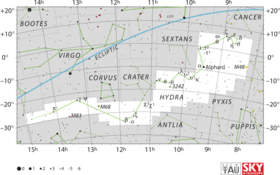Astronomy:Pi Hydrae
| Observation data Equinox J2000.0]] (ICRS) | |
|---|---|
| Constellation | Hydra |
| Right ascension | 14h 06m 22.29749s[1] |
| Declination | –26° 40′ 56.5024″[1] |
| Apparent magnitude (V) | 3.25[2] |
| Characteristics | |
| Spectral type | K1 III–IV[3] or K2-III Fe-0.5[4] |
| U−B color index | +1.040[5] |
| B−V color index | +1.120[5] |
| Astrometry | |
| Radial velocity (Rv) | +26.7[2] km/s |
| Proper motion (μ) | RA: +43.70[1] mas/yr Dec.: −141.18[1] mas/yr |
| Parallax (π) | 32.30 ± 0.16[1] mas |
| Distance | 101.0 ± 0.5 ly (31.0 ± 0.2 pc) |
| Absolute magnitude (MV) | 0.79[6] |
| Details | |
| Mass | 1.76[6] to 2.45[7] M☉ |
| Radius | 12–13[8] R☉ |
| Surface gravity (log g) | 2.65[9] cgs |
| Temperature | 4,670[9] K |
| Metallicity [Fe/H] | 0.04[10] dex |
| Rotational velocity (v sin i) | 2.25[9] km/s |
| Other designations | |
| Database references | |
| SIMBAD | data |
Pi Hydrae, Latinized from π Hydrae, is a star in the constellation Hydra with an apparent visual magnitude of 3.3,[2] making it visible to the naked eye. Parallax measurements put this star at a distance of about 101 light-years (31 parsecs) from the Earth.
The spectrum of this star shows it to have a stellar classification of K1 III-IV,[3] with the luminosity class of 'III-IV' suggesting it is in an evolutionary transition stage somewhere between a subgiant and a giant star. It has a low projected rotational velocity of 2.25 km s−1.[9] Pi Hydrae is radiating energy from its outer envelope with an effective temperature of 4,670 K,[9] giving it the orange hue of a K-type star.[12]
Pi Hydrae is a type of giant known as a cyanogen-weak star, which means that its spectrum displays weak absorption lines of CN− relative to the metallicity. (The last is a term astronomers use when describing the abundance of elements other than hydrogen and helium.) Otherwise, it appears to be a normal star of its evolutionary class, having undergone first dredge-up of nuclear fusion by-products onto its surface layers.[10] The measured angular diameter of this star, after correction for limb darkening, is 3.76 ± 0.04 mas.[13] At its estimated distance, this yields a physical size of about 12–13 times the radius of the Sun.[8] It has an estimated mass of 2.45 times the mass of the Sun.[7]
References
- ↑ Jump up to: 1.0 1.1 1.2 1.3 1.4 van Leeuwen, F. (November 2007), "Validation of the new Hipparcos reduction", Astronomy and Astrophysics 474 (2): 653–664, doi:10.1051/0004-6361:20078357, Bibcode: 2007A&A...474..653V
- ↑ Jump up to: 2.0 2.1 2.2 Wielen, R. et al. (1999), "Sixth Catalogue of Fundamental Stars (FK6). Part I. Basic fundamental stars with direct solutions", Veröff. Astron. Rechen-Inst. Heidelb (Astronomisches Rechen-Institut Heidelberg) 35 (35): 1, Bibcode: 1999VeARI..35....1W
- ↑ Jump up to: 3.0 3.1 Gray, R. O. et al. (July 2006), "Contributions to the Nearby Stars (NStars) Project: Spectroscopy of Stars Earlier than M0 within 40 pc-The Southern Sample", The Astronomical Journal 132 (1): 161–170, doi:10.1086/504637, Bibcode: 2006AJ....132..161G
- ↑ Keenan, Philip C.; McNeil, Raymond C. (1989), "The Perkins catalog of revised MK types for the cooler stars", Astrophysical Journal Supplement Series 71: 245, doi:10.1086/191373, Bibcode: 1989ApJS...71..245K.
- ↑ Jump up to: 5.0 5.1 Jennens, P. A.; Helfer, H. L. (September 1975), "A new photometric metal abundance and luminosity calibration for field G and K giants", Monthly Notices of the Royal Astronomical Society 172 (3): 667–679, doi:10.1093/mnras/172.3.667, Bibcode: 1975MNRAS.172..667J
- ↑ Jump up to: 6.0 6.1 Hekker, S. et al. (August 2006), "Precise radial velocities of giant stars. I. Stable stars", Astronomy and Astrophysics 454 (3): 943–949, doi:10.1051/0004-6361:20064946, Bibcode: 2006A&A...454..943H
- ↑ Jump up to: 7.0 7.1 Edvardsson, B. (January 1988), "Spectroscopic surface gravities and chemical compositions for 8 nearby single sub-giants", Astronomy and Astrophysics 190 (1–2): 148–166, Bibcode: 1988A&A...190..148E
- ↑ Jump up to: 8.0 8.1 Lang, Kenneth R. (2006), Astrophysical formulae, Astronomy and astrophysics library, 1 (3rd ed.), Birkhäuser, ISBN 3-540-29692-1, https://books.google.com/books?id=OvTjLcQ4MCQC&pg=PA41. The radius (R*) is given by:
- [math]\displaystyle{ \begin{align} 2\cdot R_* & = \frac{(10^{-3}\cdot 31\cdot 3.76)\ \text{AU}}{0.0046491\ \text{AU}/R_{\bigodot}} \\ & \approx 25.1\cdot R_{\bigodot} \end{align} }[/math]
- ↑ Jump up to: 9.0 9.1 9.2 9.3 9.4 Hekker, S.; Meléndez, J. (December 2007), "Precise radial velocities of giant stars. III. Spectroscopic stellar parameters", Astronomy and Astrophysics 475 (3): 1003–1009, doi:10.1051/0004-6361:20078233, Bibcode: 2007A&A...475.1003H
- ↑ Jump up to: 10.0 10.1 Luck, R. Earle (February 1991), "Chemical abundances for cyanogen-weak giants", Astrophysical Journal Supplement Series 75: 579–610, doi:10.1086/191542, Bibcode: 1991ApJS...75..579L
- ↑ "49 Hya -- Star", SIMBAD (Centre de Données astronomiques de Strasbourg), http://simbad.u-strasbg.fr/simbad/sim-id?Ident=Pi+Hydrae, retrieved 2012-01-16
- ↑ "The Colour of Stars", Australia Telescope, Outreach and Education (Commonwealth Scientific and Industrial Research Organisation), December 21, 2004, http://outreach.atnf.csiro.au/education/senior/astrophysics/photometry_colour.html, retrieved 2012-01-16
- ↑ Richichi, A.; Percheron, I.; Khristoforova, M. (February 2005), "CHARM2: An updated Catalog of High Angular Resolution Measurements", Astronomy and Astrophysics 431 (2): 773–777, doi:10.1051/0004-6361:20042039, Bibcode: 2005A&A...431..773R
External links
- Kaler, James B., "PI HYA (Pi Hydrae)", Stars (University of Illinois), http://stars.astro.illinois.edu/sow/pihya.html, retrieved 2012-01-16
 |


